![]()
![]()
![]()
Use LEFT and RIGHT arrow keys to navigate between flashcards;
Use UP and DOWN arrow keys to flip the card;
H to show hint;
A reads text to speech;
81 Cards in this Set
- Front
- Back
|
Gradient
|
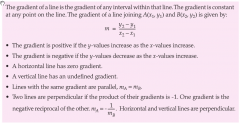
The gradient is the same at any point along a straight line.
The steeper the line, the greater the magnitude of the gradient. |
|
|
Equation of a linear graph
|
y= mx+b
where m is the gradient and b is the y-coordinate of the y-intercept (0, b). |
|
|
How to find the x-intercept and y-intercept.
|
To find the x-intercept, substitute y= 0 in the equation
To find the y-intercept, substitute x= 0 in the equation |
|
|
Other linear relationships between x and y
|
y= a, where a is a constant, is the equation of a horizontal line parallel to the x-axis. The gradient of these lines is zero.
x= b, where b is a constant, is the equation of a vertical line parallel to the y-axis. The gradient of these lines is undefined. |
|
|
Area of a rectangle
|
A= lw
|
|
|
Area of a Circle
|
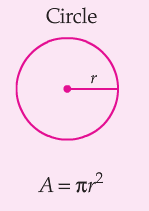
A= pi r squared
|
|
|
Area of a sector
|
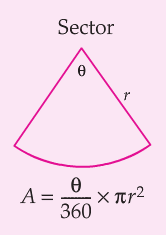
|
|
|
Area of a triangle
|
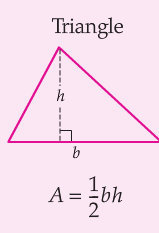
|
|
|
Area of Trapezium
|

|
|
|
Area of a Parallelogram
|

|
|
|
Area of a kite
|
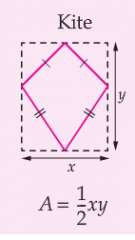
|
|
|
Area of a Rhombus
|
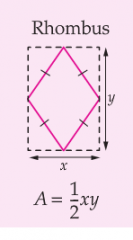
|
|
|
Composite shape
|
a shape or solid made up of more than one basic shape or solid.
|
|
|
Area of an annulus
|

|
|
|
Prism
|
A solid that has a regular shape, uniform cross-section and faces that are all polygons.
|
|
|
Uniform cross-section
|
a cross-section of a solid that is consistent from the base to the top
|
|
|
Surface area
|
the sum of the areas of all the external surfaces of a solid.
|
|
|
net
|
a series of connected shapes drawn on paper that can be folded together to form a solid.
|
|
|
Cylinder
|
A solid with a circular base and a uniform cross-section.
|
|
|
Surface area formula for a cube
|
SA= area of 6 squares
= 6l squared (2) |
|
|
Surface area formula for a Rectangular prism
|
SA= area of 6 rectangles
= 2lw + 2wh + 2lh = 2(lw + wh + lh) (factorised form) |
|
|
Surface are formula for a cylinder
|

SA = area of 2 circles and area of curved surface
= 2 pi r2 + 2pirh - 2pir (r + h) (factorised form) |
|
|
The volume of solids with constant cross-section
|
V= AH
where A is the area of the cross-section H is the perpendicular height of the solid. |
|
|
Volume of a rectangular prism
|
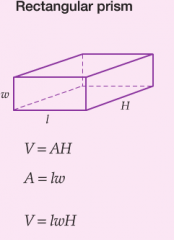
V= AH
A= lw V= lwH |
|
|
Volume of a Triangular prism
|
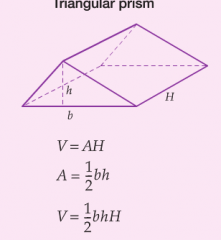
V= AH
A= 0.5bh v= .5bhH We used the lower case h for the height of the triangular-base, and the capital H for the height of the prism. |
|
|
Volume of a cylinder
|
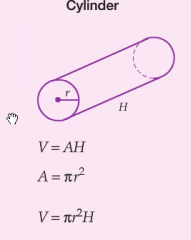
V= AH
A= pi r squared V= pi r squared H |
|
|
capacity
|
The volume of a substance (usually liquid or gas) that the container can hold.
|
|
|
1000 milliliters (mL)
|
1 litre (L)
|
|
|
1000 litres
|
1 kilolitre (kL)
|
|
|
1cm(3)
|
1mL
|
|
|
1000 cm(3)
|
1L
|
|
|
1m(3)
|
1000L= 1kL
|
|
|
Tapered solids
|
Solids in which the cross-section gets smaller as you move from the base to the top
|
|
|
Pyramids
|
a solid made up of a polygonal base and triangular sides that all meet at a vertex
|
|
|
Cone
|
a solid with a circular base that tapers through the height to a single vertex.
|
|
|
Sphere
|
a ball-shaped solid
|
|
|
Surface area formula for a square-based pyramid
|

|
|
|
Surface area formula for a cone
|

|
|
|
Surface area formula for a sphere
|

|
|
|
Volume of a tapered solid
|
V= 1/3 AH
where A is the area of the cross-section at the base H is the perpendicular height of the solid |
|
|
Volume of a cone
|
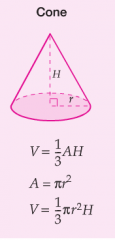
|
|
|
Volume of a Rectangular-based pyramid
|
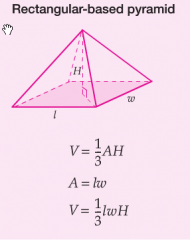
|
|
|
Volume of a sphere
|
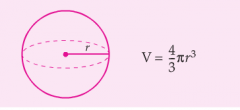
|
|
|
Real numbers
|
Numbers that can be shown on a continuous number line. They consist of all rational numbers combined with all irrational numbers.
|
|
|
Rational numbers
|
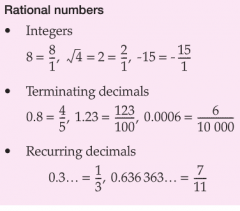
numbers that can be expressed in the form a/b, where a and b are integers and b doesn't equal 0
|
|
|
Irrational numbers
|
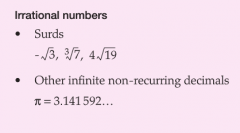
numbers that can be written in fractional form; infinite non-recurring decimals.
|
|
|
Surds
|
irrational numbers that can only be expressed exactly using the radical or root sign.
|
|
|
Multiplying surds
|
In general, √a× √b= √a×b= √ab,where a and b are positive numbers
|
|
|
Simplifying surds
|
2√3 is considered to be simpler than √12 as it contains a smaller surd
|
|
|
Dividing Surds
|
In general, (√a)/(√b)=√(a/b),where a and b are positive numbers and b ≠0.
|
|
|
Entire surd
|
a surd expression where the entire number is under the root sign, e.g. √50 rather than 5√2
|
|
|
Like surds
|
Numbers with the same surd. Only terms that contain like surds can be added or subtracted.
|
|
|
Surds and the distributive law
|

|
|
|
Rationalising the denominator
|
Rationalising the denominator of a fraction changes the denominator to a rational number, but does not change the value of the fraction.
|
|
|
Conjugate surds
|

see picture
|
|
|
How to rationalise the denominator
|
1. Multiply the numerator and denominator by the smallest surd that will give a rational denominator (if the denominator is a surd only).
2. Multiply the numerator and denominator by the conjugate of the denominator (if the denominator has rational and irrational elements). |
|
|
Sides with the same markings
|
are equal in length
|
|
|
Sides with the same number of arrows
|
are parallel.
|
|
|
||
|
'is parallel to'.
|
|
|
_I_
|
'is perpendicular to'
|
|
|
≡
|
'is congruent to'
|
|
|
∴
|
Therefore
|
|
|
III
|
'is similar to'
|
|
|
The triangle with vertices A, B and C is written as:
|
∆ ABC
|
|
|
How angles are denoted
|
Using the symbol L_; the angle at vertex A is written L_ BAC. They can also be given letter names such as α,β,∅
|
|
|
Intervals are named...
|
according to their end points; the interval between A and B is written as AB.
|
|
|
When a figure is dilated:
|
matching angles are the same
Matching side lengths are in the same ratio |
|
|
How to find the length of an unknown side in a similar triangle:
|
1. Find two pairs of matching sides that include the unknown side.
2. Equate the two ratios. 3. Solve the equation to find the exact value of the unknown, unless told otherwise. |
|
|
When showing that two shapes are congruent:
|
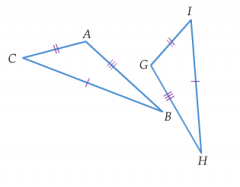
write the matching vertices in the same order. For example, in the congruent triangles shown here, the matching vertices are A and G, B and H, and C and I
So, we write that ∆ ABC ≡ ∆ GHI. This allows us to easily indentify matching sides and angles because they are in the same place in the statement. |
|
|
Midpoint theorem
|
The interval joining the midpoints of two sides of a triangle is parallel to the third side and is half its length.
|
|
|
Converse to the midpoint theorem (the inverse theorem)
|
A line drawn through the midpoint of one side of a triangle and parallel to a second side bisects the third side.
|
|
|
Intercept theorem
|
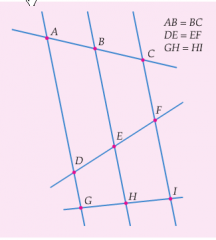
When a set of parallel lines make equal intercepts on one transversal, it makes equal intercepts on any other transversal.
|
|
|
Theorem 1
|
The angle at the centre is twice the angle at the circumference standing on the same arc.
|
|
|
Theorem 2
|
The angle in a semicircle is a right angle.
|
|
|
Theorem 3
|
Angles in the same segment subtended by the same arc at the circumference are equal.
|
|
|
Theorem 4
|
Chords of equal length in a circle subtend equal angles at the centre and are equidistant from the centre.
|
|
|
Theorem 5
|
The perpendicular from the centre of a circle to a chord bisects the chord.
|
|
|
Perpendicular
|
Two lines that intersect or meet at right angles. The product of their gradient is -1: m1 X m2 = -1.
|
|
|
perpendicular bisector
|
A line that intersects another line at a right angle and cuts the other line in half.
|
|
|
Theorem 6
|
The line from the the centre of a circle to the midpoint of a chord is perpendicular to the chord.
|
|
|
Theorem 7
|
The perpendicular bisector of a chord of a circle passes through the centre of the circle.
|

